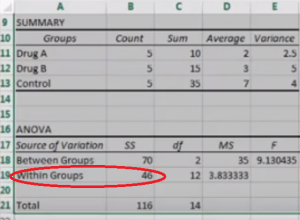Residual Variance (also called unexplained variance or error variance) is the variance of any error (residual).
The exact definition depends on what type of analysis you’re performing. For example, in regression analysis, random fluctuations cause variation around the “true” regression line (Rethemeyer, n.d.). The total variance of a regression line is made up of two parts: explained variance and unexplained variance. The unexplained variance is simply what’s left over when you subtract the variance due to regression from the total variance of the dependent variable (Neal & Cardon, 2013).

In multilevel modeling, residual variance is a reflection of the within-groups effect (Garson, 2019). Large residual variance coefficients indicate large differences within-groups (Xie, 2009). In ANOVA, Within-group variation is synonymous with residual variance.
Symbol for Residual Variance
The symbols σ or σ2 are often used to denote unexplained variance. Make sure you know the author’s intent before trying to interpret residual variance: σ may also mean standard deviation, sample standard deviation or standard error of coefficient estimates (Rethemeyer, n.d.).
Coefficient of Nondetermination
Residual variance, 1 – r2 is sometimes called the coefficient of nondetermination. The coefficient of determination, R2, shows how differences in one variable can be explained by a difference in a second variable. Therefore, 100% of a dependent variable’s variance can be explained by r2 plus the “unknown”: the unexplained variance (Meyers et al., 2006).
References
Garson, D. (2019). Multilevel Modeling: Applications in STATA®, IBM® SPSS®, SAS®, R, & HLM™. 1st Edition.
Meyers, L. et al. (2006). Applied Multivariate Research: Design & Interpretation.
Neale, M. & Cardon, L. (2003). Methodology for Genetic Studies of Twins and Families (Nato Science Series D). Springer.
Rethemeyer, K. Commonly Used Terms, Symbols, and Expressions. Retrieved April 27, 2019 from: https://www.albany.edu/faculty/kretheme/PAD705/SupportMat/CourseTerms.pdf
Xie, Y. (2009). Sociological Methodology Volume 39: 1st Edition. Wiley-Blackwell.